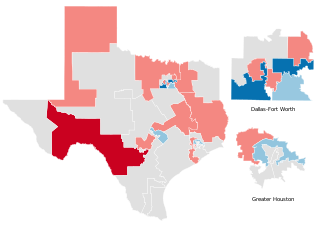| ||||||||||||||||||||||||||||||||||
15 of the 31 seats in the Texas State Senate 16 seats needed for a majority | ||||||||||||||||||||||||||||||||||
|---|---|---|---|---|---|---|---|---|---|---|---|---|---|---|---|---|---|---|---|---|---|---|---|---|---|---|---|---|---|---|---|---|---|---|
| ||||||||||||||||||||||||||||||||||
Republican hold Democratic hold Republican gain Democratic gain No election Republican: 50–60% 70–80% 80–90% | ||||||||||||||||||||||||||||||||||
| Elections in Texas |
|---|
 |
|
|
The 2018 Texas Senate elections took place as part of the biennial United States elections. Texas voters elected state senators in 15 of the state senate's 31 districts. The winners of this election served in the 86th Texas Legislature. State senators serve four-year terms in the Texas State Senate. A statewide map of Texas's state Senate districts can be obtained from the Texas Legislative Council here, and individual district maps can be obtained from the U.S. Census here.
A primary election on March 6, 2018, determined which candidates appeared on the November 6 general election ballot. Primary election results can be obtained from the Texas Secretary of State's website.[1]
Following the 2016 elections, Republicans maintained control of the Senate with 20 members. However, they gained an extra seat by flipping the 19th District in a September special election, giving them a 21-seat supermajority.[2]
To claim control of the chamber from Republicans, the Democrats would have needed to net six Senate seats. The Democratic Party gained two seats, leaving the Republicans with a 19 to 12 majority in the chamber. Republicans maintained their supermajority, however, due to a 2015 rule change that reduced the effective vote threshold to pass legislation from 21 to 19.[3]
- ^ "Election Results". Texas Secretary of State. Retrieved August 4, 2018.
- ^ Cite error: The named reference
:0was invoked but never defined (see the help page). - ^ Samuels, Alex (November 7, 2018). "Democrats Nathan Johnson and Beverly Powell defeat state Sens. Don Huffines and Konni Burton in Texas midterm". The Texas Tribune. Retrieved June 8, 2024.



